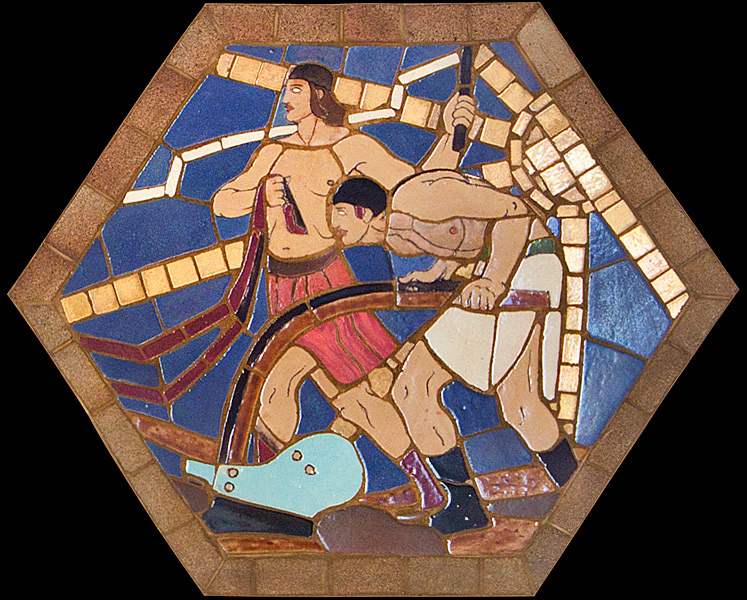Hildreth Meière Documentary Series - Watch Trailer
Hildreth Meière Documentary Series - Watch Trailer
Commissioned by: Bertram Grosvenor GoodhueIconographer: Hartley Burr AlexanderMedium: glazed ceramic tile set into acoustic tile

Detail, vestibule dome, pendentives and arch soffits
For the vestibule dome, iconographer Hartley Burr Alexander directed Hildreth Meière to depict the Gifts of Nature to Man on the Plains of Nebraska in a “no period” or biblical style.1

Vestibule dome, pendentives, and arch soffits in glazed ceramic tile
On the pendentives, Meière represented Plowing, Sowing, Cultivating and Reaping:

Plowing

Sowing

Cultivating

Reaping
Meière worked collaboratively with Goodhue and R. Guastavino to set her designs of colorful, glazed ceramic tile into Guastavino’s structural, acoustic tile of the dome. In order not to affect the dome’s acoustic properties, Meière was forced to leave half of the dome’s surface undecorated. She solved the problem by creating an all-over design of narrative vignettes enclosed within panels. Each panel is surrounded by rows of Guastavino’s beige acoustic tile. As a result, Meière’s design appears to cover the entire dome, when it actually covers less than half.

Detail of Sowing on pendentive, surrounded by beige acoustic tile
She also segmented each of her figures into irregularly shaped pieces of colored tile:2
We cut down the underglaze painting to a minimum and my designs are built up of irregularly shaped tiles, like a picture puzzle, or the early stained glass, with a cement seam instead of leading. The result is rather bold, but given height, at the relief of much plain surface around it, the result is glittering and magnificent. Each tile is set by hand, so that there is no mechanical, dead surface anywhere, and the light plays over it happily, as over good mosaics.3

Detail of Plowing showing figures in profile and shaped pieces of tile
Meière thoroughly understood the limitations of the medium for which she was designing and knew how to compensate by showing figures in profile:
I am always trying to remember the medium—and not get into something where the real meaning will be marred by the coarseness of the tile—I am after something that will interpret perfectly. . . tile being so two-dimensional, the most successful designs are those that show a profile.4
Native animals and birds in medallions adorn the soffits, or undersides of the arches.
For a full discussion, see Catherine Coleman Brawer and Kathleen Murphy Skolnik, The Art Deco Murals of Hildreth Meière (New York: Andrea Monfried Editions, 2014): 60-63.
See R. Guastavino, letter to Capitol Commission, June 26, 1924, Office of the Capitol Commission, Nebraska Capitol Collections, RG1 S1 B70 F19.
Hildreth Meière, “Distinguished Artist Comes Home for Visit: Miss Hildreth Meière Tells of the Interesting Work in which She Is Engaged,” Women’s City Club Magazine (San Francisco) 1:2 (March 1927): 11.
Meière, letter to Hartley Burr Alexander, January 3, 1926, Hartley Burr Alexander Papers, Ella Strong Denison Library, Scripps College, Claremont, California.